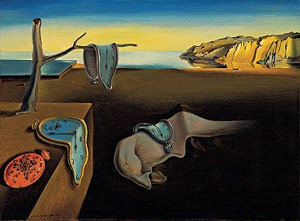| The Persistence of Memory | |
|---|---|
 |
|
| Artist | Salvador Dalí |
| Year | 1931 |
| Medium | Oil on canvas |
| Location | Museum of Modern Art, New York City |
| Dimensions | 9.5 in × 13 in |
| 24 cm × 33 cm | |
| Famous Paintings by Salvador Dalí | |
| The Persistence of Memory, 1931 | |
| The Disintegration of the Persistence of Memory, 1952-1954 | |
| The Face of War, 1940 | |
| The Ecumenical Council, 1960 | |
| Landscape Near Figueras, 1910 | |
| Christ of Saint John of the Cross, 1951 | |
| Lobster Telephone, 1936 | |
| Swans Reflecting Elephants, 1937 | |
| Apparatus and Hand, 1927 | |
| The Discovery of America by Christopher Columbus, 1959 | |
| Morphological Echo, 1934-36 | |
| The First Days of Spring, 1929 |
The Persistence of Memory was painted by Salvador Dali in 1931 and is one of his most famous works. It is currently housed in the Museum of Modern Art, New York. It has a huge fan following to date and is frequently referred to in popular culture. The surrealist artist Salvador Dali (May 11, 1904 to January 23, 1989) was born in Figueres, Spain.
The Persistence of Memory and Surrealism
Surrealism was a cultural movement which had its origins in the 1920’s. Surrealist works of art feature an element of surprise, unforeseen comparisons, and irreverent humor. At times this art, which is a free flowing expression of the artist’s imagination, is difficult to interpret and The Persistence of Memory is no exception. It uses the concept of hard and soft objects.
Expert Interpretations
The Persistence of Memory depicts a scene showing pocket watches, detached from their chains, melting slowly on rocks and branches of a tree, with the ocean as a back drop. A part of the painting is basked in sunlight and a part is shrouded in a shadow. Looking carefully you can see too small rocks, one in the sunlight and the other in the shadow.
Dali frequently used the philosophy of hard and soft in his paintings. The melting watches points to time being flowing and eternal, whereas the hard rocks are the reality of life and the ocean represents the vastness of the earth. There is an orange clock covered with ants. He used the symbolism to convey the decay of time or death (and at times, the female genitalia). The strange human figure in the center could be interpreted, as a formless person we would imagine, while we are in a dreamlike trance.
Dali’s Interpretation
There have been so many interpretations and analysis of The Persistence of Memory, but Dali never himself interpreted or explained his work. The art critic Dawn Ades wrote that “the soft watches are an unconscious symbol of the relativity of space and time”. When Dali was asked if this allusion to Einstein’s Theory of Relativity was true, he replied, rather flippantly, that it was a surrealist vision of Camembert cheese melting in the heat of the sun.
Experts have said that The Persistence of Memory was a painting during his Freudian phase of life, before the Atomic bombing of Hiroshima and Nagasaki propelled him into his scientific phase. Whatever Dali wanted to convey by the painting, he took the interpretation with him to his grave. In a strange sort of way, each of us could interpret it in our own way and would all be right. Who knows, that may be what Dali intended.
The painting has attracted the attention of art lovers for decades. Criticism and praise have been heaped on The Persistence of Memory, in equal measure. For those who favor the Surrealist genre of art, it is a masterpiece. To others it is junk, or at the best, the painting of a madman. Be that as it may, it is one work of art which will never fade away and will always provoke arguments and interpretations.